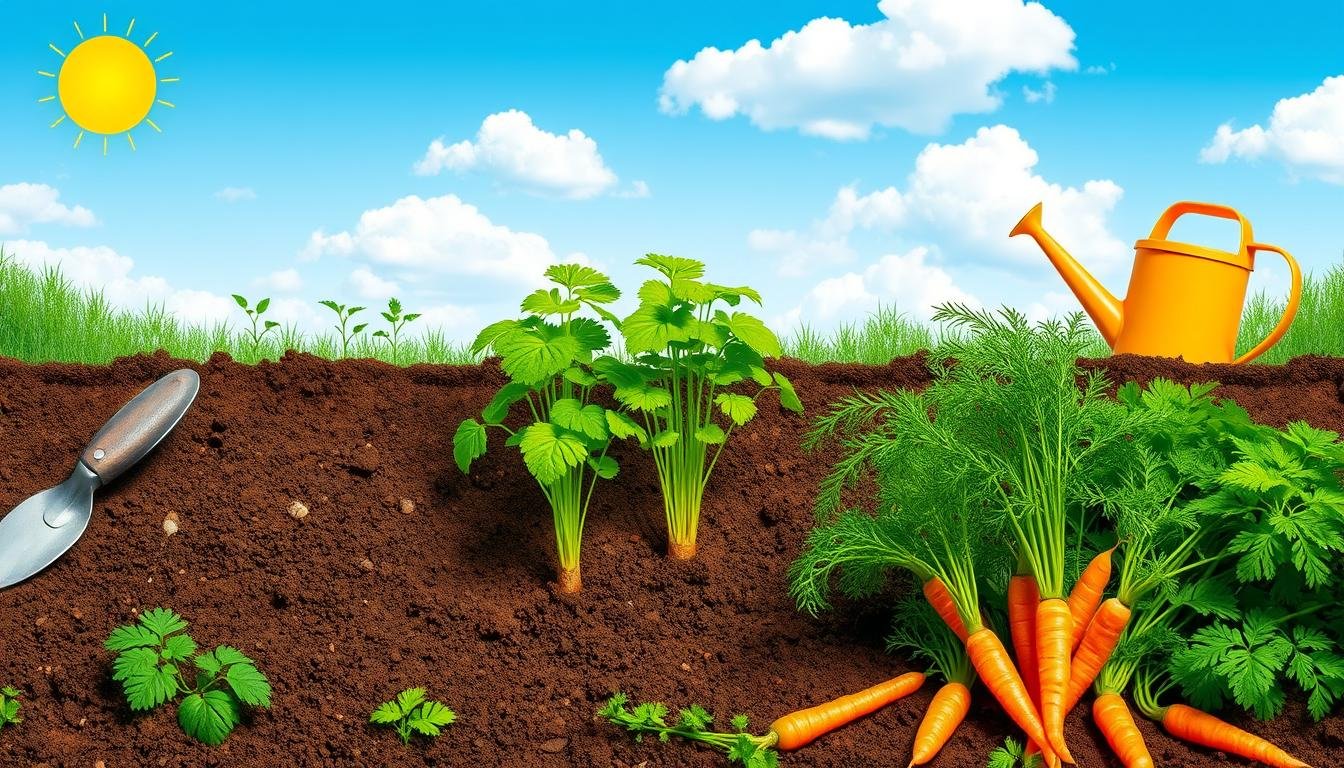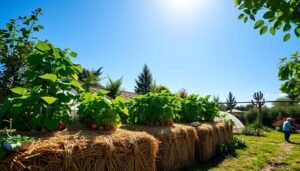Did you know carrot seeds can take three to four months to grow? This long time might seem scary, but the taste and crunch of homegrown carrots are worth it. Growing carrots from seeds is a fun gardening journey.
Starting your carrot garden? Knowing the best varieties, soil, and how to plant is key. Carrots love cooler weather, making them perfect for spring and fall. This article will guide you on how to grow carrots well and use your garden space wisely.
Looking after your carrot crop is key to healthy growth and a good harvest. Make sure your carrots get enough water. They need at least one inch of moisture each week. This helps their roots grow deep, which is important for carrots.
Table of Contents
Introduction to Carrot Gardening
Carrot gardening is a rewarding hobby for both new and seasoned gardeners. It lets you grow fresh carrots in your own backyard. This shows the joys of home gardening, making your meals better and giving you a sense of accomplishment.
To grow carrots well, you need to know the basics. They love full sun and need soil that drains well and is rich in nutrients. The soil should be deep, loose, and full of minerals to help the roots grow.
Start planting carrot seeds when the soil is at least 50 degrees in spring. It can take 7 to 21 days for them to germinate. Carrots do best in cooler weather, making them great for spring and fall.
Choosing the right carrot variety is key to a good harvest. Home gardeners often pick Nelson and Bolero for their disease resistance. You can also find carrots in purple and yellow, adding color and health benefits to your meals.
Carrots need regular care as they grow. Knowing when to harvest, between 55 to 100 days, is important for the best taste and texture. Gardening for carrots means a bountiful harvest and the joy of watching your plants grow.
Understanding Carrot Varieties
Carrot gardening offers many choices. You can pick the right carrots for your garden. This is key for growing carrots from seeds. Different carrots suit various tastes and growing conditions.
Popular Carrot Varieties for Home Gardens
Here are some top carrot varieties:
- Danvers: Grows up to 6-7 inches long, ideal for beginners.
- Nantes: Typically reaches 6-7 inches with a blunt tip, perfect for loose soils.
- Chantenay: Features shorter, conical roots, suitable for clay soils.
- Purple Cosmic: High in anthocyanins, providing health benefits.
- Yellow Solar: A sweet, newer variety with a vibrant color.
- White Lunar: Sweeter than typical orange carrots, with a mild flavor.
- Rainbow Blend: Includes unique colors like Cosmic Purple, Solar Yellow, Lunar White, and Atomic Red for visual appeal.
Choosing the Right Carrots for Your Climate
Carrots grow best in cooler temperatures. But some types do well in warmer areas. Here are tips for picking carrots:
- In cooler climates, choose varieties like Nantes or Bolero, which mature quickly.
- For warmer areas, try Imperator carrots like ‘Autumn King’ or Atomic Red, both of which can grow longer roots.
- Make sure your chosen carrot variety fits your local growing conditions for a successful harvest.
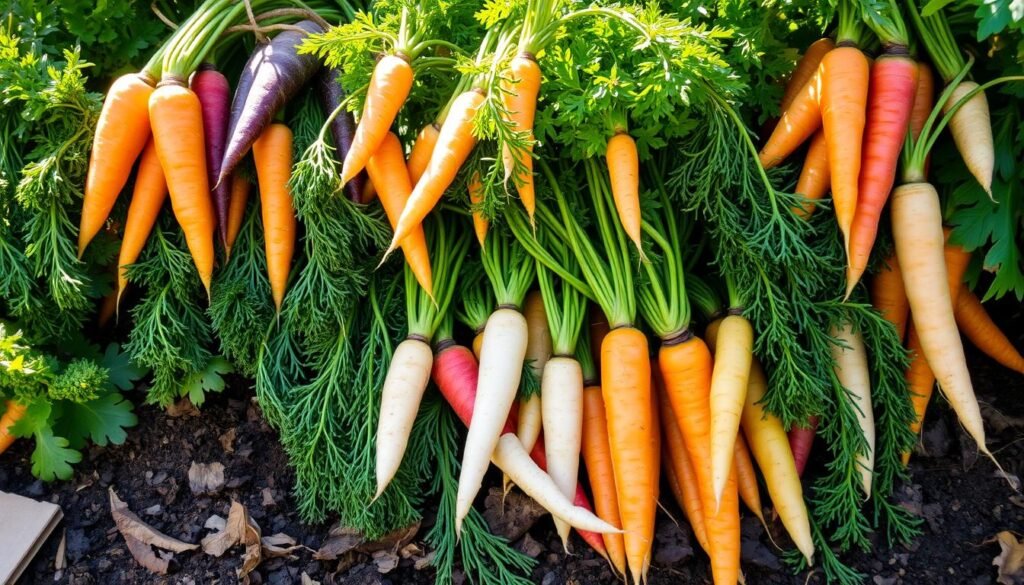
How to Grow Carrots: Essential Soil Requirements
Carrots need the right soil to grow well. They do best in deep, fertile soil that drains well. This means sandy or loamy soil is perfect for them.
Soil that’s too heavy can stop carrots from growing. Adding compost helps a lot. It makes the soil better and helps carrots grow strong.
Before you plant, test your soil. This tells you what nutrients it lacks. Then, you can add the right stuff to help carrots grow.
The best soil pH for carrots is between 6.0 and 6.8. This pH helps them absorb nutrients better. Here’s a table to help you get your soil just right:
| Soil Component | Ideal Conditions |
|---|---|
| Soil Type | Sandy or Loamy |
| Soil pH | 6.0 – 6.8 |
| Drainage | Well-Drained |
| Nutrients | Balanced Fertility (based on soil test) |
| Temperature for Seed Germination | 55-65°F |
With the right soil, carrots will be vibrant and tasty. Paying attention to soil needs is key to a great harvest.
Preparing Your Garden Bed for Carrot Planting
Creating the perfect garden bed is key to growing great carrots. Good soil preparation is vital for healthy roots. By using carrot gardening techniques and adding organic materials, your carrots will grow well and give you a big harvest.
Soil Preparation Techniques
Start by checking your garden site. Carrots love rich, loose soil that lets roots grow deep. Important steps for soil preparation include:
- Double Digging: Break up the soil at least 12 inches deep to improve aeration.
- Broadforking: Use a broadfork to aerate the soil without disturbing its structure.
- Soil Testing: Test for pH and nutrient levels to optimize conditions.
- Drainage Improvement: Ensure proper drainage to prevent waterlogging.
Using Organic Matter for Enhanced Growth
Adding organic matter to your garden bed makes the soil healthier. Using organic matter, like compost or well-rotted manure, makes the soil rich in nutrients. This helps your carrots grow well.
- Improved Soil Structure: Loose soil promotes better root growth and ease of harvest.
- Enhanced Nutrient Content: Organic materials supply essential nutrients that encourage healthy carrot development.
- Increased Moisture Retention: This helps maintain consistent moisture levels, vital for carrot seed germination.
- Enhanced Microbial Activity: Healthy soil biology supports robust plant growth.
When making a raised bed, remember carrots do well in beds that warm up fast in spring. This lets you plant them earlier. Paying close attention to these steps in soil preparation will help you have a great carrot harvest.
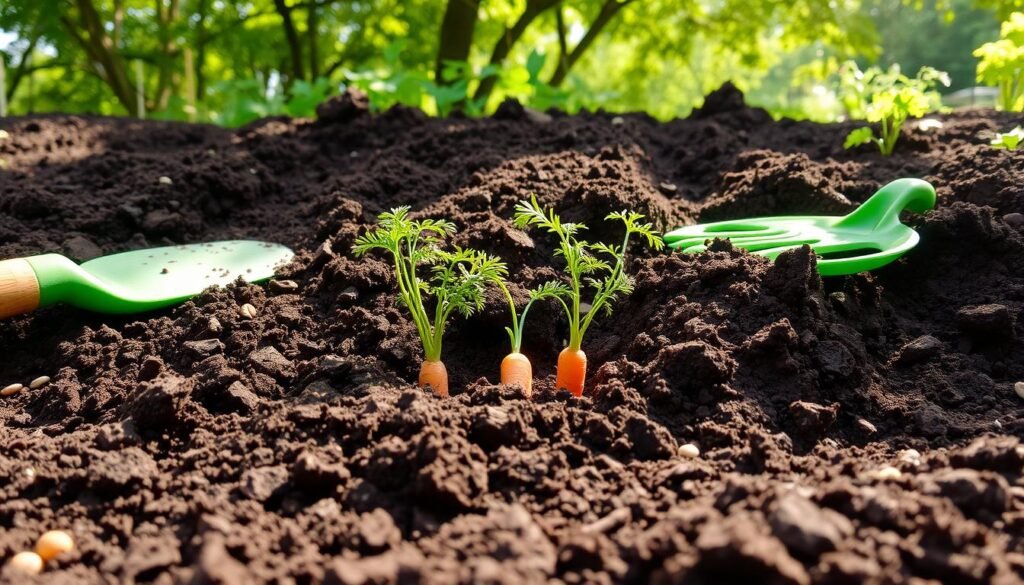
Carrot Planting Techniques
Knowing the best ways to plant carrots is key to a good harvest. The timing and spacing of carrots are critical for their growth. This section will help you find the best time to plant and how to space them for a bountiful crop.
When and How to Plant Carrots
Plant carrots directly in the garden when the soil is soft in early spring. This is about 3 to 5 weeks before the last frost. The soil should be between 45°F and 85°F (7°C to 29°C) for planting.
Plant the seeds about ¼ inch (0.6 centimeters) deep. You can choose from different carrot colors like purple, white, red, yellow, and orange. After planting, add fertilizer to the rows two weeks later. Do this again when the plants are 8 to 10 inches (20-25 cm) tall. Make sure to thin out the seedlings when they’re 2 to 3 inches tall to allow each carrot to grow big in pots.
Spacing and Depth Considerations
Spacing is key for carrots to grow well and avoid deformities. Thin the seedlings to 2 inches (5 cm) apart when they’re 1-2 inches (2.5-5 cm) tall. This gives each carrot room to grow.
Keep rows 12 to 18 inches apart for easy care. Mulching helps keep weeds away and keeps the soil moist. Make sure the carrot tops stay under the soil to prevent them from turning green and bitter.

| Planting Technique | Details |
|---|---|
| When to Plant | 3 to 5 weeks before the last frost |
| Sowing Depth | 1/4 inch (0.6 cm) |
| Spacing Between Seeds | 2 inches (5 cm) |
| Row Spacing | 12 to 18 inches |
| Seedling Thin Distance | 2 inches (5 cm) |
| Soil Temperature Range | 45°F to 85°F (7°C to 29°C) |
Caring for Your Carrot Crop
Looking after your carrot crop is key to healthy growth and a good harvest. Make sure your carrots get enough water. They need at least one inch of moisture each week. This helps their roots grow deep, which is important for carrots.
But, don’t overwater. Too much water can cause root rot and other problems.
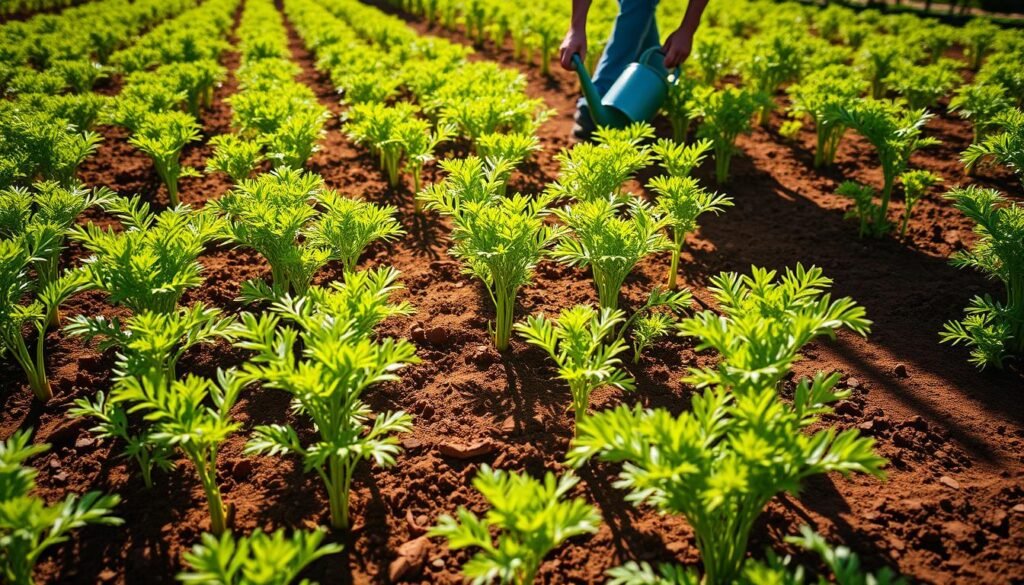
Weeding is also very important. Weeds take away nutrients and water from your carrots. Check your garden often and remove weeds carefully. This way, you won’t harm your carrots.
Mulching around your carrots helps keep weeds away and keeps the soil moist. This is good for your carrots.
It’s also important to watch out for pests and diseases. Carrots can get damaged by pests like the carrot rust fly and carrot weevils. Look for signs of damage early. Use natural pest control methods if needed.
- Practice proper watering techniques.
- Utilize mulching to retain moisture and suppress weeds.
- Monitor regularly for pests and diseases.
- Thin your crop as needed to avoid overcrowding.
Succession planting can help you have carrots all season. Plant new seeds every few weeks. This way, you’ll have a steady supply of fresh carrots.
| Care Task | Details |
|---|---|
| Watering | 1 inch of water per week; shallow watering encourages deeper roots. |
| Weeding | Remove weeds regularly; use mulch to prevent growth. |
| Pest Monitoring | Check for pests weekly; act early to manage any infestations. |
| Thinning | Thin seedlings to 3 inches apart for optimal growth. |
| Succession Planting | Sow seeds in intervals to prolong carrot availability. |
Follow these tips to grow a healthy carrot crop. With the right care, your carrots will grow well. You’ll have plenty of delicious carrots for cooking.
Watering and Irrigation Tips for Growing Carrots
Watering carrots right is key to growing healthy ones. It helps them grow strong roots and taste great. Carrots need steady moisture, most when they’re starting to grow. Using the right irrigation tips can help you get a big harvest.
Maintaining Soil Moisture
Keeping the soil moist is vital all season long. Carrots need about 1 inch of water each week. This helps them grow big and juicy without problems. Water them lightly but deeply to avoid hurting the seedlings.
Using drip irrigation is a smart way to keep the soil moist. It delivers water right to the roots, keeping the soil evenly wet.
When to Water for Optimal Growth
When you water matters a lot. Seeds need steady moisture when they’re germinating, which takes 1 to 3 weeks. As they grow, they need less water but deeper soaking. In hot, dry weather, you might need to water more often.
But, don’t overwater. Too much water can cause roots to fork or grow cracks. So, watch the soil closely to avoid these problems.
| Condition | Watering Frequency | Soil Moisture Level |
|---|---|---|
| Germination (1-3 weeks) | Every other day | Evenly moist |
| Early Growth | 2-3 times a week | Maintaining moisture |
| Mature Plants | Weekly | Deep moisture, less often |
By following these tips, you’ll grow a great crop of carrots.
Pest Control and Managing Diseases
Keeping your carrots healthy means controlling pests and diseases. Common pests can harm your crop’s quality and yield. It’s important to spot and deal with these problems early to keep your garden thriving.
Common Insects Affecting Carrots
Several pests can threaten your carrots, including:
- Carrot rust flies: These pests lay eggs near the base of the carrot plants, and their larvae feed on the roots, causing damage.
- Parsley worms: They can strip leaves, leading to decreased photosynthesis and stunted growth.
- Root-knot nematodes: These microscopic roundworms invade the roots, resulting in swelling and poor carrot development.
- Slugs: These mollusks can create holes in leaves, making plants more vulnerable to diseases.
- Carrot-aster yellows: This disease is transmitted by leafhoppers and affects the overall vigor of the carrot plants.
Preventative Measures for Healthy Growth
Here are some ways to prevent diseases:
- Use row covers to keep pests away while letting in sunlight and moisture.
- Rotate your crops to break pest and disease cycles.
- Watch your plants for pests and diseases. Catching them early can save your crop.
- Choose carrot varieties that resist pests and diseases.
- Keep your garden clean. Remove debris that pests and diseases can hide in.
Controlling pests and diseases is key to a healthy crop. Regular checks and quick action can make your carrots healthier and more abundant.
| Pest | Damage Caused | Control Methods |
|---|---|---|
| Carrot Rust Fly | Larvae feed on roots, causing damage. | Row covers, crop rotation. |
| Parsley Worms | Leaves stripped, hindering growth. | Handpicking, insecticidal soap. |
| Root-Knot Nematodes | Roots swell, impacting development. | Crop rotation, resistant varieties. |
| Slugs | Holes in leaves, increasing disease risk. | Beer traps, organic slug bait. |
| Carrot-Aster Yellows | Affects vigor and vitality of plants. | Control leafhoppers, remove infected plants. |
Harvesting Your Carrots
Knowing when to harvest carrots is key to their quality and taste. Look for signs of maturity. High-quality carrots are about ¾ to 1 inch thick at the shoulder. They take 60 to 80 days to grow, but some types need more time.
Check your carrots often to catch the perfect harvest time.
Signs of Mature Carrots
Here are signs your carrots are ready:
- The carrot shoulder is the right size.
- The leaves are green and healthy.
- The roots are firm and straight.
- Carrots can get sweeter if you wait a bit longer.
Best Practices for Harvesting and Storing
When carrots are ready, harvest them carefully to avoid damage:
- Water the garden a day before to make soil softer.
- Use a fork to loosen the soil, then pull out the carrots by hand.
After harvesting, store carrots properly to keep them fresh:
- Keep them in a cool, humid place (32–38°F, 98% humidity).
- They can last several months if stored well.
- Use bins or the fridge for homegrown carrots.
For winter markets, washing carrots is a risk. It’s safer to leave them unwashed. This keeps beneficial bacteria and avoids stains. Some carrot varieties, like ‘Bolero,’ store well for a long time.
Conclusion
Carrot gardening is all about the details for a great harvest. You need to pick the right variety for your area and make the soil rich in nutrients. Each step is important.
By using the right techniques for planting, caring, and harvesting, you get to enjoy carrots’ great taste and health benefits. They’re full of vitamin A and potassium.
Try different carrot types like Danvers or Scarlet Nantes to make gardening more fun. Freshly picked carrots are way better than store-bought ones. They make your garden a place of learning and fun.
Remember, growing carrots takes time. It usually takes 70–100 days to see your hard work pay off. So, get your tools ready and start planting. Your home-grown carrots are waiting for you!

